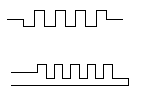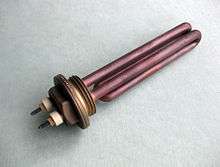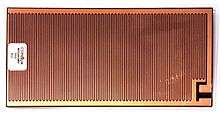Heating element



A heating element converts electricity into heat through the process of resistive or Joule heating. Electric current passing through the element encounters resistance, resulting in heating of the element. Unlike the Peltier effect, this process is independent of the direction of current flow.
Metal heating elements
- Nichrome: Most heating elements use nichrome 80/20 (80% nickel, 20% chromium) wire, ribbon, or strip. Nichrome 80/20 is an ideal material, because it has relatively high resistance and forms an adherent layer of chromium oxide when it is heated for the first time. Material beneath this layer will not oxidize, preventing the wire from breaking or burning out.
- Resistance wire: Metallic resistance heating elements may be wire or ribbon, straight or coiled. They are used in common heating devices like toasters and hair dryers, furnaces for industrial heating, floor heating, roof heating, pathway heating to melt snow, dryers, etc. The most common classes of materials used include:
- Kanthal (FeCrAl) wires
- Nichrome 80/20 wire and strip
- Cupronickel (CuNi) alloys for low temperature heating
- Etched foil: Etched foil elements are generally made from the same alloys as resistance wire elements, but are produced with a subtractive photo-etching process that starts with a continuous sheet of metal foil and ends with a complex resistance pattern. These elements are commonly found in precision heating applications like medical diagnostics and aerospace.
Ceramic heating elements
- Molybdenum disilicide: Molybdenum disilicide (MoSi2) an intermetallic compound, a silicide of molybdenum, is a refractory ceramic primarily used in heating elements. It has moderate density, melting point 2030 °C, and is electrically conductive. At high temperatures it forms a passivation layer of silicon dioxide, protecting it from further oxidation. The application area includes glass industry, ceramic sintering, heat treatment furnaces and semiconductor diffusion furnaces.
- PTC ceramic elements: PTC ceramic material is named for its positive thermal coefficient of resistance (i.e., resistance increases upon heating). Most ceramics have a negative coefficient, whereas most metals have positive values. While metals do become slightly more resistant at higher temperatures, this class of ceramics (often barium titanate and lead titanate composites) has a highly nonlinear thermal response, so that it becomes extremely resistive above a composition-dependent threshold temperature. This behavior causes the material to act as its own thermostat, since current passes when it is cool, and does not when it is hot. Thin films of this material are used in automotive rear-window defrost heaters, and honeycomb-shaped elements are used in more expensive hair dryers and space heaters.
Polymer PTC heating elements

Resistive heaters can be made of conducting PTC rubber materials where the resistivity increases exponentially with increasing temperature.[1] Such a heater will produce high power when it is cold, and rapidly heat up itself to a constant temperature. Due to the exponentially increasing resistivity, the heater can never heat itself to warmer than this temperature. Above this temperature the rubber acts as an electrical insulator. The temperature can be chosen during the production of the rubber. Typical temperatures are between 0 and 80 °C (32 and 176 °F).
It is a point wise self-regulating heater and self-limiting heater. Self-regulating means that every point of the heater independently keeps a constant temperature without the need of regulating electronics. Self-limiting means that the heater can never exceed a certain temperature in any point and requires no overheat protection.
Composite heating elements
- Tubular heating elements: Tubular (sheathed) elements normally comprise a fine coil of nichrome (NiCr) resistance heating alloy wire, that is located in a metallic tube (of stainless steel alloys, such as Incoloy, or copper) and insulated by magnesium oxide powder. To keep moisture out of the hygroscopic insulator, the ends are equipped with beads of insulating material such as ceramic or silicone rubber, or a combination of both. The tube is drawn through a die to compress the powder and maximize heat transmission. These can be a straight rod (as in toaster ovens) or bent to a shape to span an area to be heated (such as in electric stoves, ovens, and coffee makers).
- Screen-printed elements: Screen-printed metal–ceramic tracks deposited on ceramic insulated metal (generally steel) plates have found widespread application as elements in kettles and other domestic appliances since the mid-1990s.
- Radiative heating elements (heat lamps): A high-powered incandescent lamp usually run at less than maximum power to radiate mostly infrared instead of visible light. These are usually found in radiant space heaters and food warmers, taking either a long, tubular form or an R40 reflector-lamp form. The reflector lamp style is often tinted red to minimize the visible light produced; the tubular form comes in different formats:
- Gold coated - Made famous by the patented Phillips Helen lamp. A gold dichroic film is deposited on the inside that reduces the visible light and allows most of the short and medium wave infrared through. Mainly for heating people. A number of manufacturers now manufacture these lamps and they improve constantly.
- Ruby Red coated - Same function as the gold-coated lamps, but at a fraction of the cost. The visible glare is much higher than the gold variant.
- Clear - No coating and mainly used in production processes.
- Removable Ceramic Core Elements : comprising coiled resistance heating alloy wire threaded through one or more cylindrical ceramic segments to make a required length (related to output), with or without a centre rod. Inserted into a metal sheath or tube sealed at one end, this type of element allows replacement or repair without breaking into the process involved, usually fluid heating under pressure.
Combination heating element systems
- Thick film technology: Heating elements for high-temperature furnaces are often made of exotic materials, including platinum, molybdenum disilicide, molybdenum (vacuum furnaces) and silicon carbide. Silicon carbide igniters are common in gas ovens. Laser heaters are also being used for achieving high temperatures in thick film technology.[2]
- Electric stove: Early electric stoves used tubular heating elements for all functions, but some are using other technology for the surface burners to produce a smooth-top range that is easier to clean.
See also
- Thermoelectric effect
- Positive temperature coefficient
- Heated hose
- Heating mantle
- Molybdenum disilicide
References
- ↑ US patent 6,734,250
- ↑ Rashidian Vaziri, M R; et al. "New raster-scanned CO2 laser heater for pulsed laser deposition applications: design and modeling for homogenous substrate heating". Optical Engineering. 51 (4): 044301. doi:10.1117/1.OE.51.4.044301.